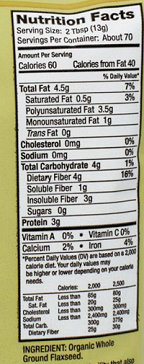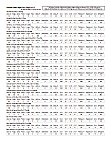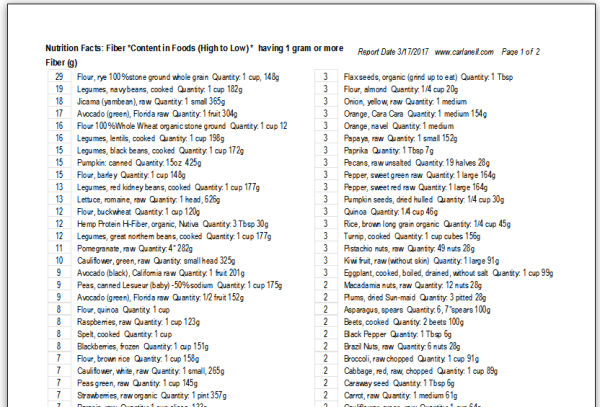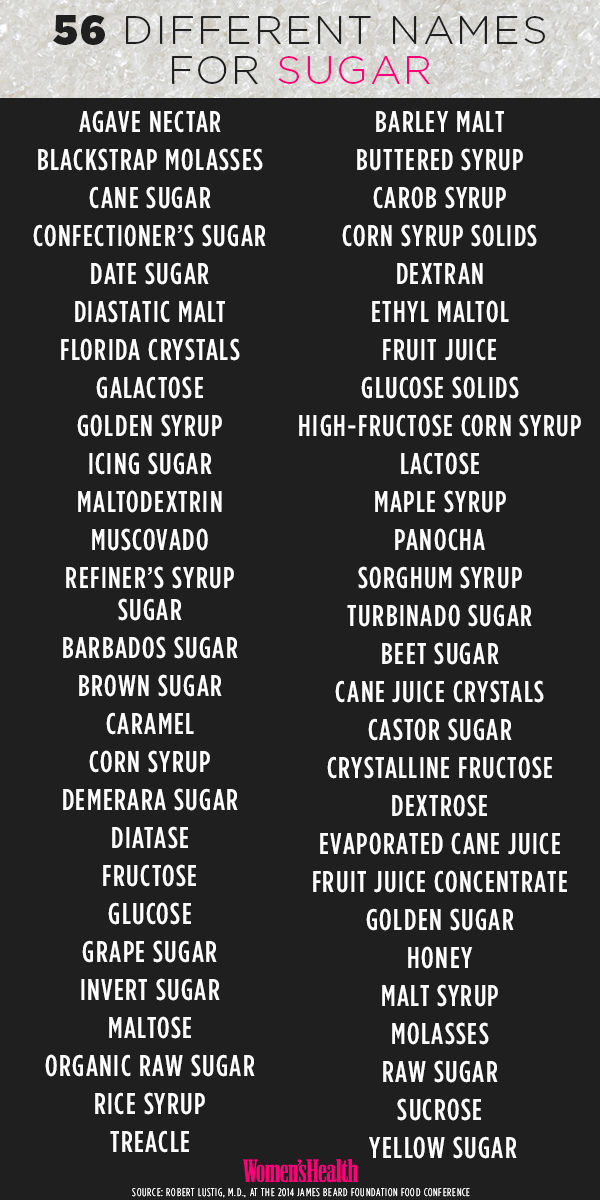Healthy Eating Resources
Healthy Eating Topics (on this website)
- Calcium in Food
- Cholesterol Facts
- Dairy Nutrition Facts
- Fiber Facts
- Foods to Avoid
- Fruits Nutrition Facts
- Grains Nutrition Facts
- Health and Nutrition for Kids at Culinary Schools.org
- Iron in Food
- Magnesium in Food
- Motivation for Healthy Eating
- MyPlate.gov for Healthy Eating
- Nutrients in Food (High to Low)
- Nutrition Facts by Food Groups
- Nutrition Facts by Food Name
- Nutrition Resources on the Internet
- Organic Food Choices
- Oils/Nuts/Seeds Nutrition Facts
- Omega-3 in Food
- Potassium in Food
- Protein Nutrition Facts
- Sodium Facts
- Spices Etc. Nutrition Facts
- Sugar in Foods High to Low
- Sugars Nutrition Facts
- Vegan Nutrition Facts by Food Groups
- Vegetables Nutrition Facts
- Vitamin A in Food
- Vitamin C in Food
- Vitamin D in Food
- Vitamin E in Food
- Zinc in Food
Advertising claims do NOT make something "Healthy"
Look at the Food Ingredients List

- The food ingredients list is at the bottom of the nutrition facts label. Ingredients are what determine whether a food or beverage is healthy or not. Don't be fooled by advertising saying "low fat, low calorie, gluten free, or natural". The ingredients are listed by quantity order (largest to smallest in quantity). If the ingredients list is loaded with chemical names and words you cannot pronounce, this is not a healthy item. Look for foods items without added sugar.
- When choosing foods at stores, read NUTRITION FACTS labels which are found on most all foods and beverages. This web site has Nutrition Facts information for many foods.
- Drink (48 - 64 ounces) of pure water per day. Water can be obtained from both eating foods with lots of water content as well as drinking water alone. Stay hydrated appropriately to your climate and activity level and your specific health needs.
- Eat Less of the Nutrient-Poor Foods by the American Heart Association
http://www.heart.org/HEARTORG/HealthyLiving/HealthyEating/Nutrition/The-American-Heart-Associations-Diet-and-Lifestyle-Recommendations_UCM_305855_Article.jsp?appName=MobileApp - Eat foods that are rich in nutrients.
Nutrient Dense Foods
Nutrient rich foods contain higher levels of vitamins and/or minerals. Eating nutrient dense foods gives your body more nutritional bang for your buck. Your body will thank you with improved health. Organic foods have higher levels of nutrients than non-organic foods. See the vitamins/minerals items below for foods listed according to nutrient amounts:
Motivation, Resources for Healthy Eating, Nutrition and Fitness
Consult your physician to determine your general daily calorie intake standard. Know what your maximum daily calorie intake should be based on your age, height and weight and your specific nutritional requirements and any specific health needs.
Books:
- "Bright Line Eating: The Science of Living Happy, Thin, and Free" by Susan Peirce Thompson
https://susanpeircethompson.com/book/" - "YOU: The Owners Manual" by Michael F. Roizen, MD and Mehmet C. Oz, MD.
http://www.doctoroz.com/book/you-owners-manual - "Younger (Thinner) You Diet" by Eric R. Braverman, MD.
"https://www.amazon.com/Younger-Thinner-You-Diet-Understanding-ebook/dp/B0072IO8DS/ref=dp_kinw_strp_1"
Helpful Web Sites (listed alphabetically):
- BrightLineEating.com: https://brightlineeating.com/
- Calorie Counter/Nutrition Data: http://caloriecount.about.com/
- Calorie King web site: http://www.calorieking.com/
- CDC.gov Healthy Living: http://www.cdc.gov/HealthyLiving/
- CDC.gov Nutrition For Everyone:
http://www.cdc.gov/nutrition/everyone/index.html - ComplaintsList.com: A Guide for Consumers About Food Safety:
http://www.complaintslist.com/a-guide-for-consumers-about-food-safety/ - ComplaintsList.com: Consumer Safety: An Official Guide to Dietary Supplements:
http://www.complaintslist.com/consumer-safety-an-official-guide-dietary-supplements/ - Complete Health Improvement Program | CHIP Health: http://www.chiphealth.com/
- CulinarySchools.org (Health and Nutrition for Kids):
http://www.culinaryschools.org/cooking-school-types/kids/health-and-nutrition.php - The Daily Plate web site: http://www.thedailyplate.com/
- Fit Day web site: http://www.fitday.com/WebFit/Index.html
- The George Mateljan Foundation (World's Healthiest Foods): http://www.whfoods.org
- "Dr. Gundry's New Food Pyramid for Vitality ("The Plant Paradox" diet)"
http://gundrymd.com/food-pyramid/ - "Health and Fitness Guide for Students", Family Dental Group, Flint Michigan
http://www.flintfamilydentist.com/health-and-fitness-guide-for-students/ - Health Maintenance For Kids at Mapcon.com:
www.mapcon.com/health-maintenance-for-kids - "Health Review: A Complete Guide to Nutrition and Fitness", USinsuranceAgents.com
https://usinsuranceagents.com/health-reviews-nutrition-fitness - How To Cook Recipes
https://www.howtocook.recipes/" - Keeping a Healthy Diet and Fighting Eating Disorders:
http://www.dietspotlight.com/keeping-a-healthy-diet-and-fighting-eating-disorders/ - "Mayo Clinic Health Lifestyle" page http://www.mayoclinic.org/healthy-lifestyle
- Medical and Health Games For Kids
http://www.claricode.com/content/Medical-and-Health-Games-For-Kids.aspx - My Fitness Pal.com
https://www.myfitnesspal.com/ - 9round.com (fitness and nutrition articles):
https://www.9round.com/articles/fitness-and-nutrition - Nutrition Data web site: http://nutritiondata.self.com/
- Nutrition and Diet Tools from The Medifast Plan
http://www.dietsciencenews.com/feature-articles/nutrition-and-diet-tools/ - Put That Cookie Down Now! is a blog for people looking for practical tips about health, wellness, fitness, and nutrition plus up-to-date health and wellness news.
projectputthatcookiedownnow.com - Safestars.org Food Safety: http://safestars.org/food-safety/
- Sleepopolis.com "Proper Sleep, Health, and Nutrition for Athletes"
https://sleepopolis.com/education/proper-sleep-health-and-nutrition-for-athletes/ - Well-beingsecrets: http://www.well-beingsecrets.com
PDF Nutrition Fact Sheets for Download
Most of the nutrition facts information on this website was compiled from the Nutrition Facts labels printed on food packaging. Additional food nutrient facts were taken from various database libraries on the Internet.

All Foods Sorted by Food Groups, Adobe Acrobat file:
nutrition_facts_by_food_group.pdf
(file size: 736 KB, data updated: 03/16/2017)
All Foods Sorted by Food Name, Adobe Acrobat file:
nutrition_facts.pdf
(file size: 720 KB, data updated: 03/16/2017)
Vegan Foods Sorted by Food Groups, Adobe Acrobat file:
vegan_nutrition_facts_by_food_group.pdf
(file size: 699 KB, data updated: 03/16/2017)
Fiber in Food (High to Low), Adobe Acrobat format file:
fiber_content_high2low.pdf
(file size: 112 KB, data updated: 03/16/2017)
If you do not have Adobe Reader installed on your computer, you can download a free copy from the Adobe website.
Measurements for Good Health
Maximum Waist Size
Your maximum waist size should be half your height in inches. Measure at the navel with your stomach totally sucked in because you are measuring for belly fat -- not muscle tone.
- 5'0" = 60 inches = 30 inch waist
- 5'2" = 62 inches = 31 inch waist
- 5'4" = 64 inches = 32 inch waist
- 5'6" = 66 inches = 33 inch waist
- 5'8" = 68 inches = 34 inch waist
- 6'0" = 70 inches = 35 inch waist
- 6'2" = 72 inches = 36 inch waist
- 6'4" = 74 inches = 37 inch waist
- 6'6" = 76 inches = 38 inch waist
- 6'8" = 78 inches = 39 inch waist
Maximum Neck Size
According to Dr. Mehmet Oz, extra fat around the neck causes difficulties with breathing when asleep due to body fat constricting the airways. Dr. Oz recommends a maximum neck size of no more than 16 to 17 inches.
Body Mass Index
A body mass index range between 18.5 - 24.9 is considered to be normal. Anything above 24.9 is considered overweight. A BMI of 30 or greater is considered obese.
BMI equals a person's weight in kilograms divided by height in meters squared. (BMI=kg/m2).
Tools on the Internet for calculating Body Mass Index:
A good starting point for determining a healthy weight is one that gives you a normal Body Mass Index for your height.
- Mayo Clinic body mass index calculator
https://www.mayoclinic.com/health/bmi-calculator/NU00597
MyPlate.gov Healthy Eating Plan
The plate picture to the left is a great guideline for how to portion healthy foods onto a plate for each meal.
See USDA's chooseMyPlate.gov plan on this website
Organic versus Non-Organic Produce
1. Organic produce is better because toxic pesticides are not used.
2. People who eat, grow, and harvest organic produce are not exposed to toxic pesticides.
Choose organic for protein and dairy products and choose organic options based on two lists below:
Choose Organic for these:
- Apples
- Bell Peppers
- Blueberries
- Broccoli
- Carrots
- Cauliflower
- Celery
- Cherries
- Grapes
- Kale
- Nectarines
- Peaches
- Potatoes (red, russet)
- Romaine lettuce
- Spinach
- Strawberries
Can choose non-organic for these:
- Asparagus
- Avocado
- Cabbage
- Canteloupe
- Corn
- Eggplant
- Grapefruit
- Honeydew melon
- Kiwi
- Mangoes
- Onions
- Pineapple
- Sweet Peas
- Sweet Potato
- Watermelon
If organic options are unavailable, clean fruits and vegetables with produce spray:
Clean and Healthy Produce Spray
Ingredients
1 cup water
1 cup distilled white vinegar
1 tbsp baking soda
1/2 of a lemon (use juice)
Directions
Combine all ingredients in a large container. Transfer to a spray bottle with a pump. Spray mixture on produce and let sit for 5 minutes. Scrub and rinse.
About Fiber Intake
Fiber in the diet lowers cholesterol, is good for digestive health, helps curb hunger, and helps curb cravings for sweets. Recommendations for fiber intake range from 25 grams to 45 grams per day.
Fiber Recommendation by the American Heart Association
Whole Grains and Fiber article
Fiber in Foods (High to Low) * having 1 gram or more
fiber_content_high2low.pdf
(file size: 112 KB, data updated: 03/17/2017)

About Sodium (salt) Intake
The maximum sodium intake for one day should not exceed 2300 mg. High salt intake causes high blood pressure. High blood pressure causes heart attack and stroke. Table salt has the most sodium and also contains dextrose. Kosher salt is 52% lower in sodum than table salt; Sea salt is 20% lower in sodium than table salt.
- Why Should I Limit Sodium? by the American Heart Association:
https://www.heart.org/idc/groups/heart-public/@wcm/@hcm/documents/downloadable/ucm_300625.pdf
| Sodium (mg) | |
|---|---|
| 2325 | Salt, table Quantity: 1 teaspoon |
| 1872 | Salt, sea salt Quantity: 1 teaspoon |
| 1680 | Salt, Himalayan Pink Quantity: 1 teaspoon |
| 1120 | Salt, coarse kosher Quantity: 1 teaspoon |
Sodium is present naturally in some raw fruits and vegetables in modest levels. However canned, frozen, or highly processed foods (and especially fast foods) more often have added salt. Read the ingredients in processed, canned or frozen foods to find items without added sodium. You might pay slightly more for food with less sodium, but that should be worth the health benefits.
Sodium Content in Foods (High to Low -- 100 mg and Higher Only)
List updated: March 17, 2017

About Cholesterol Intake
Cholesterol is produced naturally by the liver, thus zero cholesterol from food is needed. Fruits, vegetables, seeds, and plant foods are all cholesterol free. Cholesterol in food comes from animal meat, poultry, and dairy products. The maximum cholesterol intake from foods should be no more than 300 mg per day.
Cholesterol in Foods (High to Low)
List updated: March 16, 2017

Food and Ingredients to Avoid for Healthy Eating
- any food containing Olean or Olestra
- diet soft drinks AND non-diet soft drinks
- foods containing monosodium glutamate (MSG's)
- foods containing nitrates (bacon, hot dogs, processed lunch meats)
- foods with added growth hormones or antibiotics
- foods that have been genetically modified; GMOs (genetically modified organisms)
- soybean oil
Is Soy Bad For You Or Good? https://authoritynutrition.com/is-soy-bad-for-you-or-good/ - yogurt with added sugar or labeled as being probiotic
- foods with lots of added salt
- foods and beverages with added sugar (sugar has lots of names, see section below)
- unwashed foods containing pecticides, see produce spray recipe above
About Sugar
The only real healthy sugar is whole fruit.
https://www.womenshealthmag.com/food/a19981764/different-names-for-sugar/

